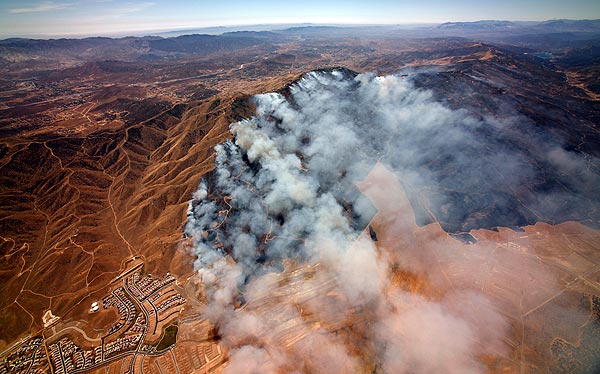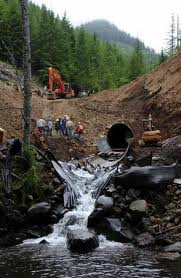
We keep trying to stop the fires
Essay -Published in High Country News here August 12, 2010 by Char Miller
Scorched earth and gnarled oaks lit up like flares. Blackened skies and the whomp-whomp-whomp of helicopters aloft as evacuees huddle in a local school. This quick-cut imagery can mean only one thing in California: The summer fire season has begun.
Although the first major fires in the Southern California counties of Kern and Los Angeles have been contained, the larger lessons to be drawn from this trio of late-July fires already are obvious. The stunning devastation from last summer’s Station Fire, and the political inferno it ignited, is driving a much-more aggressive firefighting response this summer.
Take the wind-whipped Bull Fire. It started July 26 in the Sequoia National Forest, and within three days had swept through 16,000 acres of grass and brush along the Kern River, near the town of Kernville. Nearly 2400 fire-fighting personnel battled the blaze, at their command an impressive arsenal of 124 fire engines, five bulldozers, 16 water tenders, and 14 helicopters. That ground and air technology, combined with 99 hand crews doing the essential back-breaking labor to clear fire lines around the perimeter, was a sign of the seriousness with which this early outbreak was taken.
Every bit as significant was the swift reaction to the West Fire. It flared up July 27, not far from major wind farms. The same gusting force that turns those turbines propelled the fire through the kindling-dry landscape; within two days it had burnt through an estimated 1400 acres. However small it may have appeared, the West also drew a major crew to extinguish it: more than 1000 firefighters from county, state, and federal agencies worked in conjunction with eight helicopters, nine fixed-wing aircraft and a fleet of engines and dozers.
They also got a governor. Not one to miss a fire-action photo-op, Gov. Arnold Schwarzenegger made an appearance at Tehachapi High School, command post for the West’s operations. He did what governors should do, praising the first responders and declaring Kern County a disaster area, a declaration that frees up additional state funding for the emergency. But his most critical contribution was in showing up. His presence underscores that politics, not science, is determining when and how fires will be fought.
True, one reason so many firefighters raced to the West Fire, and another 1750 were quickly dispatched to the fast-moving 14,000-acre Crown Fire near Palmdale, is that these areas have not burned in a very long time. The fuel load, and thus the level of fire danger, was (and remains) extreme.
Yet another reason why so many resources were hurled at Bull, West, and Crown fires is the searing memory of the 2009 fire that got away. Last August, a small, arson-ignited fire in the Angeles National Forest blew up into the single largest conflagration in the history of Los Angeles County. When the Station Fire finally was brought under control in October, it had torched more than 250 square miles of the San Gabriel Mountains, killed two firefighters and destroyed countless structures.
Its charred acres have become an in-your-face warning to firefighting agencies across the state. So have Congressional hearings that charged the Forest Service with mismanagement and media investigations that unearthed damning evidence about a possible cover-up of its actions. Because no agency head wants to endure such public scrutiny, and because no one wants to bear witness to the anguish of burned-out communities, every fire now is going to get hit hard.
This is not the smartest response. Not all fires must be controlled; some are essential to maintain ecosystem health. Not all firefighting makes economic sense, either. Yes, the commitment to protect human life is non-negotiable, the swift punishment of arsonists is essential and the need for more funds to fireproof the wildland-urban interface is critical.
But it is also true that Californians and other Westerners must become a lot smarter about where they choose to live. If they decide to reside in fire zones, they need to learn how to safely inhabit those areas so as not to endanger the lives of those racing to their rescue.
In the immediate aftermath of the Station Fire, these cautionary insights have gone up in smoke. Now that fire has become so politicized, whenever and wherever sparks fly, a small army of firefighters will storm in and flame-retardant will rain down.
Char Miller is a contributor to Writers on the Range, a syndication service of High Country News (hcn.org). He is director of the environmental analysis program at Pomona College in California and the author of Gifford Pinchot and the Making of Modern Environmentalism.







